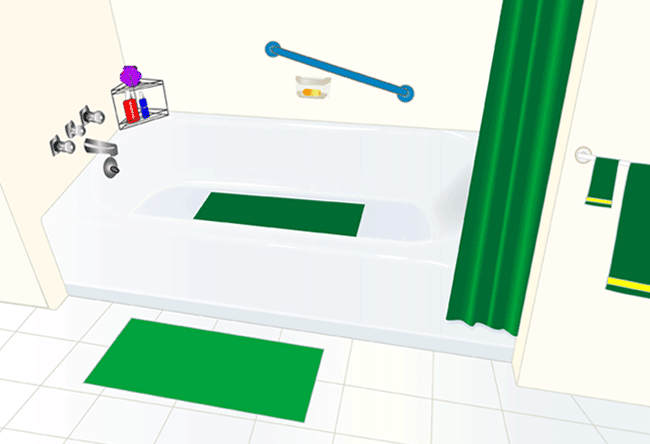Editor’s Note: Today’s post is from guest blogger, Jackie Waters. Jackie is a mother of four boys and lives on a farm in Oregon. She is passionate about providing a healthy and happy home for her family and aims to provide advice for others on how to do the same through her own website. She has recently had an older relative come live with her and, together, they worked on needed changes in the home to make it safe and easy to access. We are sharing this for Older Americans Month to help caregivers and their loved ones who are encountering similar situations.
A Stranger in Your Own Home
If you’re dealing with some sort of visual impairment—whether it be from injury,
age-related macular degeneration, or eye disease—you might feel like a bit of a stranger in your own home. When vision is compromised, routine living in even a familiar house can become unfamiliar. Of course, your ultimate goal is to maintain your independence. The good news is that the majority of those with a visual impairment can easily make changes around the house to accommodate their condition.
When we had to accommodate my sister-in-law, who recently moved in with us, it was a challenge at first. But she was able to give me great ideas and input on how to make our house more accessible for her. I especially love how her ideas dovetail perfectly with my fondness for organization and decluttering.

Go Big and Bold
For most people with visual impairments, the bigger the lettering the better. This isn’t just important when you’re trying to read the morning paper. You need to think about how everything is
labeled around your house. You can label drawers, shelves, cabinets, and boxes with large bold lettering on contrasting colors. For instance, you can use light colored construction paper with a bold black marker to label your T-shirt drawer or the cabinet with all of your baking dishes. You need to determine the best contrasting color arrangement for your older relative. For example, yellow and black may be a good combination.
Of course, if your visual impairment makes reading even the largest, boldest lettering difficult, you should rely on striking
color contrast or even different textures to label things around your house.
Install Grab Bars in High-Risk Places
Even if you have full or close to full mobility, it may help to have a little extra protection from trips, slips, and falls around your house. Installing grab bars in high-risk areas like bathrooms, the kitchen, and near elevation changes can help. Speaking of the bathroom, bath stools and color-contrasted bath mats are all good investments. It’s also worth considering rugs with rubber backing that will cling to floors and help avoid unnecessary slipping or falling.

Remove the Clutter
Removing clutter especially unnecessary rugs and cords and getting super organized has multiple benefits. First, you’ll know where things are.
Organizing your home and tossing out anything you don’t need will save you a lot of stressful days of trying to locate a certain item when you can’t remember what drawer it’s in. According to VisionAware, “Give away or throw away any article of clothing you haven’t worn in more than a year. If you didn’t like a jacket or pair of slacks enough to wear it in all that time, you won’t miss it.”
Also, add dividers to your drawers to separate sweaters, scarves, underwear, and various other items that end up in a jumble when there are no boundaries to keep them in order. Having a method that you can remember and that works for you is the most important thing you can do when organizing your home.
Second, getting the clutter out means a safer living environment. Having random stuff laying on the floor is a recipe for trips and falls. One thing you can do is to make sure all of your pathways around the house are free of thick rugs that may be hard to spot and extension cords that run across the middle of rooms. Additionally, if you have children living in the home, which we do, it’s a good idea to enlist them in helping to keep toys and games off the floor and out of the way, preferably in a room or area that isn’t high-traffic.
Independence Often Requires Accepting Some Help
Independent living isn’t the same thing as solitary living. If you need help, don’t be stubborn. Ask a family member or friend to assist you in making
home modifications or have them do the hard stuff around the house if you don’t feel comfortable doing it. You can also consider hiring a housekeeper (we just talked about the importance of decluttering). If you choose to seek out professional help with keeping your house tidy, it’s important to go into the process with a clear understanding of your own needs. A good housekeeper will have proper qualifications, a schedule that can work with yours, and will be able to accommodate your personal organizational desires around the house.
I hope my suggestions and tips have been helpful in your quest to maintain your independence in your home. Are there any changes that you have made that I didn’t mention? What ideas have you found useful that you can share with others?
Resources for Modifying Your Home
Organizing and Modifying the Home for Individuals Who Are Blind or Visually Impaired
Home Evaluation: Questions to Ask Yourself When Creating a Safe Home for People with Vision Loss
Wardrobe Combos: Time-Saving Tips for People Who Are Blind or Have Low Vision
Jackie Water’s Website 
